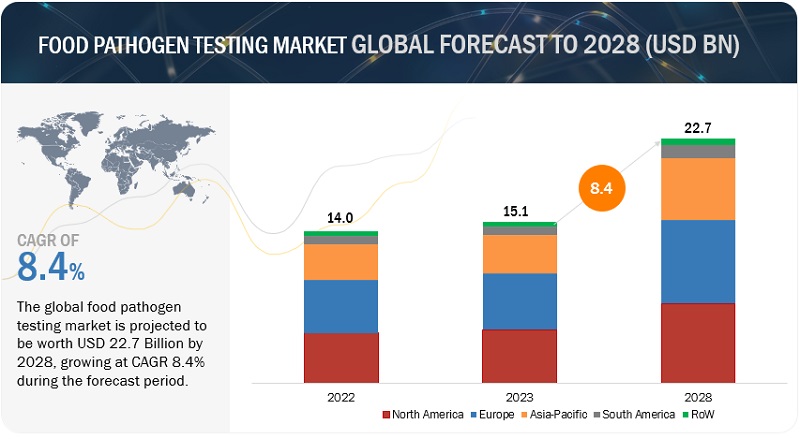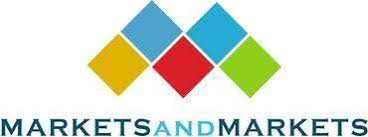The food pathogen testing market size is predicted to grow at a CAGR of 8.4% between 2023 and 2028, reaching a value of $22.7 billion by 2028 from a projection of $15.1 billion in 2023. Food pathogen testing has been witnessing an increasing trend on a global level due to the rising incidences of foodborne disease outbreaks, globalization of food trade, consumer awareness, implementation of food safety regulations, and advancement in modern testing technology. The market in North America has been growing consistently due to many foodborne disease outbreaks in the region, owing to salmonella and campylobacter occurrences. The market has been witnessing dynamic growth due to increasing concerns about food contamination, spoilage, and foodborne illnesses. The market has been experiencing growth driven by increasing consumer awareness of food safety and media influence related to food safety issues.

Food Pathogen Testing Industry Overview
The food pathogen testing industry plays a critical role in ensuring the safety and quality of food products consumed by the public. This sector is dedicated to identifying and preventing the presence of harmful microorganisms, such as bacteria, viruses, and parasites, in various food items.
Overview:
Foodborne illnesses pose a significant threat to public health, making stringent testing procedures essential throughout the food production and distribution chain. The Food Pathogen Testing industry addresses this concern by employing advanced techniques to detect and analyze potential contaminants in food samples.
Key Components:
1. Microbial Testing: This involves the identification and quantification of microorganisms like Salmonella, E. coli, Listeria, and Campylobacter. Techniques include PCR (Polymerase Chain Reaction), ELISA (Enzyme-Linked Immunosorbent Assay), and traditional culture methods.
2. Allergen Testing: Ensuring that food products are free from common allergens like peanuts, tree nuts, soy, wheat, and milk is crucial. Specialized tests are employed to detect even trace amounts of allergens.
3. Toxin Testing: Detection of toxins produced by bacteria or fungi, such as mycotoxins, is essential. This includes aflatoxins, which can contaminate crops like grains and nuts.
4. Genetic Testing: Advancements in genetic technology enable the identification of specific genetic markers associated with foodborne pathogens. This helps in accurate and rapid detection.
Food Pathogen Testing Market Trends
The Food Pathogen Testing market is witnessing several notable trends that are shaping its growth trajectory:
1. Stringent Food Safety Regulations: Increasing concerns about foodborne illnesses and outbreaks have led to the implementation of stringent regulations by governments worldwide. This has fueled the demand for robust pathogen testing solutions to ensure food safety and compliance with regulatory standards.
2. Technological Advancements: The food pathogen testing industry is experiencing rapid technological advancements, including the development of innovative testing methods such as PCR (Polymerase Chain Reaction), immunoassays, biosensors, and next-generation sequencing. These advanced technologies offer faster, more accurate, and efficient detection of pathogens in food samples.
3. Shift towards Rapid Testing Methods: There is a growing preference for rapid testing methods that deliver quick results, enabling food manufacturers to take immediate corrective actions and prevent the distribution of contaminated products. This shift is driven by the need to streamline production processes and minimize the risk of foodborne outbreaks.
4. Increasing Adoption of Automated Solutions: Food manufacturers are increasingly adopting automated pathogen testing solutions to improve efficiency, reduce labor costs, and enhance accuracy in testing procedures. Automation allows for higher throughput and standardized testing protocols, thereby improving overall productivity and reliability.
5. Rising Consumer Awareness: With increasing consumer awareness about food safety and hygiene, there is a greater demand for products that undergo rigorous pathogen testing. Food companies are responding by investing in comprehensive testing programs to build consumer trust and confidence in their products.
6. Focus on Preventive Measures: There is a growing emphasis on preventive measures within the food industry to proactively identify and mitigate potential risks associated with foodborne pathogens. This includes implementing Hazard Analysis and Critical Control Points (HACCP) plans and investing in advanced testing technologies as part of comprehensive food safety management systems.
7. Expansion in Emerging Markets: The food pathogen testing market is witnessing significant growth opportunities in emerging markets due to urbanization, changing dietary habits, and increasing disposable incomes. As a result, there is a rising demand for food safety testing solutions to meet the evolving needs of consumers in these regions.
Food Pathogen Testing Market Opportunities: Technological advancements in the testing industry
The COVID-19 pandemic has had an impact on the field of food safety testing technology because it has stressed out many workforces. As a result, businesses have had staffing issues, particularly in areas requiring specialized knowledge and training, such as lab technicians. The techniques needed to assure food safety increasingly depend heavily on accuracy and efficiency. Nucleic acids can be found using a variety of methods, including PCR, qPCR, RT-PCR, LAMP, and others, most notably ELISA, ELFA, and lateral flow, for antibody-based detection. When it comes to identifying strains, food safety technology uses sequencing and NGS. Traditional serotyping, MLST, PFGE, DNA arrays, and bead-based arrays are further technological tools.
Foodborne illness is a major concern around the world that affects thousands of people each year. The Typhimurium variant has been responsible for about a quarter of Salmonella outbreaks since the 1960s. Researchers trained a machine-learning algorithm on more than 1,300 Typhimurium genomes with known origins. Finally, the algorithm was able to identify the origin of foodborne illness by correctly predicting which animal sources—primarily poultry and swine—would have the Typhimurium genome. AI is also used to reduce food waste. Researchers in Singapore have developed a meat-freshness “nose” powered by AI. It operates by responding to the gases released as the meat starts to spoil. As food can be tested to determine whether it is safe to consume regardless of the “best before” date, this could help reduce food waste.
Download PDF Brochure: https://www.marketsandmarkets.com/pdfdownloadNew.asp?id=202386163
Meat & Poultry is estimated to dominate the food type segment in the food pathogen testing market.
The meat and poultry industry is the subject of this research, and it comprises ground beef, ground pig, lunch meat, beef, meat alternatives, ground chicken, ground turkey, cooked chicken, and raw chicken parts. Meat and poultry product contamination happens mostly during packaging, processing, and insufficient storage practices that fail to maintain the requisite appropriate temperature. Escherichia coli (E. coli), Salmonella, and Campylobacter are the most frequent pathogens identified in meat and Poultry.
The food industry is highly concerned about pathogen contamination in meat, Poultry, and seafood due to the potential risks it poses to public health. These food products can be contaminated by various pathogens, including bacteria, viruses, and parasites. Ingesting such pathogens without proper safeguards in place can lead to foodborne diseases. The presence of pathogens like Salmonella, E. coli, Campylobacter, Listeria monocytogenes, and Vibrio species in animal-derived products emphasizes the importance of implementing stringent food safety procedures throughout the entire manufacturing and supply chain.
The Asia Pacific market is projected to dominate the food pathogen testing market.
Japan is one of the largest markets for food pathogen testing in the Asia-Pacific region. It is also estimated to be a mature market with a steady growth rate; however, concerns for food safety are still important to the country, owing to which the enforcement of stringent food sanitation laws has become mandatory. The Japanese scrutiny system has revealed food poisoning through pathogens to be the largest outbreak across Japan. E. coli was the major pathogen that caused severe foodborne diseases in Japan.
In Australia, food pathogen testing has gained a significant level of importance owing to frequent increases in the number of foodborne disease outbreaks, increasingly stringent regulations on food safety, a growing level of trade between Australia and other countries, and a sustained number of food recalls, among other reasons. The implementation of a food safety system has reduced the incidences of foodborne diseases in Australia. The development in technologies and the increasing number of regulatory norms have fuelled the growth of this market. The Australian food industry is using strict quality control standards and verifies.
Food Pathogen Testing Market Share
SGS Société Générale de Surveillance SA (Switzerland), Bureau Veritas (France), Intertek Group Plc. (UK), Eurofins Scientific (Europe), ALS (Australia), JBT(US), and TÜV NORD GROUP (Germany) are among the key players in the global market. To increase their company’s revenues and market shares, companies are focusing on launching new services, developing partnerships, and expanding their laboratory facilities. The key strategies used by companies in the market include geographical expansion to tap the potential of emerging economies, strategic acquisitions to gain a foothold over the extensive supply chain, and new service launches as a result of extensive research and development (R&D) initiatives.
About MarketsandMarkets™
MarketsandMarketsTM has been recognized as one of America’s best management consulting firms by Forbes, as per their recent report.
MarketsandMarkets™ is a blue ocean alternative in growth consulting and program management, leveraging a man-machine offering to drive supernormal growth for progressive organizations in the B2B space. We have the widest lens on emerging technologies, making us proficient in co-creating supernormal growth for clients.
Earlier this year, we made a formal transformation into one of America’s best management consulting firms as per a survey conducted by Forbes.
The B2B economy is witnessing the emergence of $25 trillion of new revenue streams that are substituting existing revenue streams in this decade alone. We work with clients on growth programs, helping them monetize this $25 trillion opportunity through our service lines – TAM Expansion, Go-to-Market (GTM) Strategy to Execution, Market Share Gain, Account Enablement, and Thought Leadership Marketing.
Built on the ‘GIVE Growth’ principle, we work with several Forbes Global 2000 B2B companies – helping them stay relevant in a disruptive ecosystem. Our insights and strategies are molded by our industry experts, cutting-edge AI-powered Market Intelligence Cloud, and years of research. The KnowledgeStore™ (our Market Intelligence Cloud) integrates our research, facilitates an analysis of interconnections through a set of applications, helping clients look at the entire ecosystem and understand the revenue shifts happening in their industry.
Media Contact
Company Name: MarketsandMarkets™ Research Private Ltd.
Contact Person: Mr. Aashish Mehra
Email: Send Email
Phone: 18886006441
Address:630 Dundee Road Suite 430
City: Northbrook
State: IL 60062
Country: United States
Website: https://www.marketsandmarkets.com/Market-Reports/food-pathogen-testing-market-202386163.html

